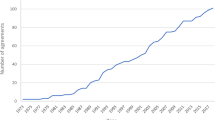Abstract
Two decades of New Public Management have placed agencifiction high on the agenda of administrative policy-makers. However, agencification (and de-agencification) has been one of the enduring themes of public administration. Agencies organized at arm’s length from ministerial departments have fairly often been located outside of the capital or political centre. Although practitioners tend to assign some weight to central versus peripheral location as regards political-administrative behavior, this relationship has been almost totally ignored by scholars in the field. In this paper, based on a large-N elite survey, we show that agency autonomy, agency influence and inter-institutional coordination seem to be relatively unaffected by agency site. This study also specifies some conditions under which this finding is valid.
Similar content being viewed by others
References
Aberbach, J., Putnam, R. D., & Rockman, B. A. (1981). Bureaucrats and politicians in western democracies. Cambridge: Harvard University Press.
Barbieri, D., & Ongaro, E. (2008). EU Agencies: what is common and what is distinctive compared with national-level public agencies. International Review of Administrative Sciences, 74, 395–419.
Christensen, T., & Lægreid, P. (2006). Agencification and regulatory reforms. In T. Christensen & P. Lægreid (Eds.), Autonomy and regulation. Coping with agencies in the modern state. Cheltenham: Elgar.
Egeberg, M. (1994). Bridging the gap between theory and practice: the case of administrative policy. Governance, 7, 83–98.
Egeberg, M. (2003). How bureaucratic structures matters: An organizational perspective. In B. G. Peters & J. Pierre (Eds.), Handbook of public administration. London: SAGE.
Egeberg, M., & Trondal, J. (2009). Political leadership and bureaucratic autonomy: effects of agencification. Governance, 22, 673–688.
European Commission. (2005). Interinstitutional agreement on the operating framework for the European Regulatory Agencies. Brussels: COM(2005)59 final.
European Commission. (2008). European agencies—the way forward. Brussels: COM(2008)135 final.
Goodsell, C. T. (1977). Bureaucratic manipulation of physical symbols: an empirical study. American Journal of Political Science, 21, 79–91.
Goodsell, C. T. (1988). The social meaning of civic space. Studying political authority through architecture. Lawrence: University Press of Kansas.
Groenleer, M. (2006). The European commission and agencies. In D. Spence & G. Edwards (Eds.), The European commission. London: Harper.
Gulick, L. (1937). Notes on the theory of organization. In L. Gulick & L. Urwick (Eds.), Papers on the science of administration. New York: Institute of Public Administration.
Hatch, M. J., & Cunliffe, A. L. (2006). Organization theory. Oxford: Oxford University Presss.
Haverland, M. (2006). Methodology. In P. Graziano & M. P. Vink (Eds.), Europeanization. New research agendas. Basingstoke: Palgrave Macmillan.
Hommen, K. O. (2003). Tilsynspolitikk i Norge: Utflytting og autonomi. Bergen: Stein Rokkan Senter for flerfaglige samfunnsstudier, Report No. 17.
Jablin, F. M. (1987). Formal organization structure. In F. M. Jablin, L. Putnam, K. Roberts, & L. Porter (Eds.), Handbook of organizational communication. An interdisciplinary perspective. Newbury Park: Sage.
Jacobsen, D. I. (1989). Effekter av forvaltningens fysiske organisering på beslutningsatferden. In M. Egeberg (Ed.), Institusjonspolitikk og forvaltningsutvikling. Oslo: Tano.
Jönsson, C., Tägil, S., & Törnqvist, G. (2000). Organizing European space. London: Sage.
Meyer, C. B., & Stensaker, I. G. (2009). Making radical change happen through selective inclusion and exclusion of stakeholders. British Journal of Management Review, 20, 219–237.
Norman, V. D. (2004). Blue notes. Politikkens paradokser. Bergen: Vigmostad & Bjørke.
Pfeffer, J. (1982). Organizations and organization theory. Boston: Pitman.
Pollitt, C., & Bouckaert, G. (2004). Public management reform. Oxford: Oxford University Press.
Pollitt, C., Talbot, C., Caulfield, J., & Smullen, A. (2004). Agencies. How governments do things through semi-autonomous organizations. Palgrave Macmillan: Houndmills.
Rokkan, S., & Urwin, D. (1982). The politics of territorial identity. London: Sage.
Szapiro, M. (2005). The framework for European regulatory agencies: a balance between accountability and autonomy, Paper presented at ECPR General Conference, Budapest, 8–11 September 2005, Hungary.
Therborn, G. (2006). Why and how place matters. In R. E. Goodin & C. Tilly (Eds.), The Oxford handbook of contextual political analysis. Oxford: Oxford University Press.
Thynne, I. (2003). Making sense of organizations in public management: a back-to-basics approach. Public Organization Review, 3, 317–332.
Trondal, J., & Jeppesen, L. (2008). Images of agency governance in the European union. West European Politics, 31, 417–441.
Van Knippenberg, D., & Van Leeuwen, E. (2001). Organizational identity after a merger: Sense of continuity as the key to postmerger identification. In M. A. Hogg & D. J. Terry (Eds.), Social identity processes in organizational context. Ann Arbor: Psychology.
Verhoest, K., Peters, B. G., Bouckaert, G., & Verschuere, B. (2004). The study of organizational autonomy: a conceptual review. Public Administration and Development, 24, 101–118.
Wettenhall, R. (2005). Agencies and non-departmental public bodies. The hard and soft lenses of agencification theory. Public Management Review, 7(4), 615–635.
Yesilkagit, K., & van Thiel, S. (2008). Political influence and bureaucratic autonomy. Public Organization Review, 8, 137–153.
Author information
Authors and Affiliations
Corresponding author
Rights and permissions
About this article
Cite this article
Egeberg, M., Trondal, J. Agencification and Location: Does Agency Site Matter?. Public Organiz Rev 11, 97–108 (2011). https://doi.org/10.1007/s11115-010-0113-8
Published:
Issue Date:
DOI: https://doi.org/10.1007/s11115-010-0113-8




